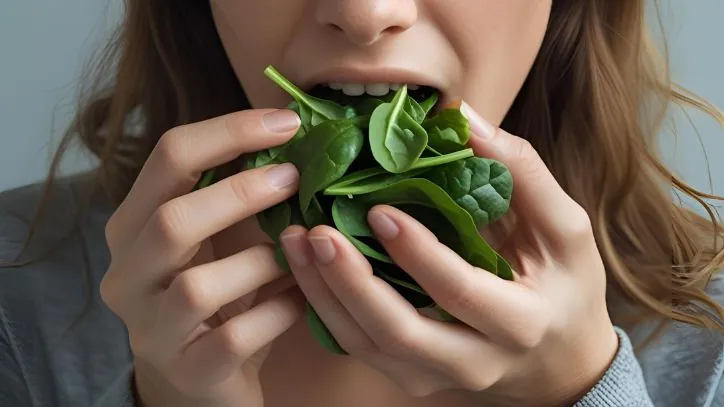Blog
The Raw Spinach Morning Trend: A Closer Look at the Hype

In early 2025, a quirky wellness trend swept across TikTok: the practice of eating a handful of raw spinach first thing in the morning. Social media influencers and health enthusiasts alike have touted this habit as a game-changer—claiming it can boost energy, curb cravings, and “set the tone” for a nutritious day. With spinach’s well-earned reputation as a nutrient powerhouse, it’s no surprise this leafy green has taken center stage in the wellness lexicon.
Arizona agriculturalists have expressed their satisfaction with the enthusiasm surrounding spinach, a leafy green they grow in abundance during the winter months. But the question arises: is consuming raw spinach every morning the golden ticket to optimal health? Nutritionists suggest that the conversation is more nuanced than the trend’s proponents might imply, and it leads to the fundamental notion of dietary variety and balance.
The Rise of the Raw Spinach Craze
The trend that began in early 2025 can be traced back to platforms like TikTok, where users have taken to posting videos depicting their morning rituals involving raw spinach. The simplicity of grabbing a handful of fresh leaves straight from the fridge and consuming them has made it accessible to many. Clips abound of vibrant green leaves being stuffed into mouths, often accompanied by captions that praise spinach for its fiber, antioxidants, and vitamins. Some enthusiasts even claim that this ritual has trained their taste buds to resist sugary snacks throughout the day.
The nutritional profile of spinach supports the positive buzz surrounding it. Per cup, spinach is a veritable goldmine, packed with vitamins A, C, and K, along with iron, folate, and calcium, all contributing to a mere 7 calories. With data from the Dietary Guidelines for Americans indicating that only 10% of adults meet their daily vegetable intake needs, this new habit feels like a significant win in the quest for healthier eating.

However, as the fad continues to grow, so do the questions surrounding it. Is eating raw spinach the best way to unlock its benefits? And is munching on this leafy green every morning truly enough to catalyze noticeable improvements in your health? Experts are stepping up to provide insight and guidance, emphasizing a smarter, more balanced approach to incorporating spinach—and other vegetables—into one’s diet.
What Nutritionists Say: The Pros and Cons
Nutritionists recognize that spinach is an excellent choice—whether consumed raw or in cooked forms. “Spinach is low in calories but dense in essential nutrients,” asserts Melissa Jaeger, head of nutrition at MyFitnessPal. Antioxidants such as lutein and zeaxanthin have been shown to support eye health, while potassium may contribute to lowering blood pressure, and the fiber content aids in digestion. The mental aspect of establishing a morning habit also plays a crucial role. “Starting your day with a healthy habit can mentally set you up for success,” notes registered dietitian Dolores Woods of UTHealth Houston.
Research supports the idea that forming routines can reinforce positive lifestyle changes. A study published in the American Journal of Lifestyle Medicine found that consistency in healthy eating patterns can significantly influence weight management and metabolic health (American Journal of Lifestyle Medicine).
However, there are notable caveats. Raw spinach contains oxalates, which are natural compounds that can bind to minerals such as calcium and iron, potentially hindering their absorption. For most individuals, this isn’t a significant concern, but for those predisposed to kidney stones or those on blood thinners—due to spinach’s high vitamin K content—caution is advised (Harvard Health). Additionally, consuming a single handful—approximately one cup—falls short of the two to three cups of vegetables that adults are advised to include in their daily intake.
Furthermore, while the claim that raw spinach curbs cravings is touted widely, it is less robust on scrutiny. While it’s true that fiber can promote feelings of fullness, there is minimal evidence to suggest that consuming a handful of spinach alone has a lasting impact on appetite regulation throughout the entire day.
A Better Way: Variety and Balance
Rather than relying solely on raw spinach as a breakfast staple, nutritionists encourage a varied intake of vegetables to maximize health benefits while mitigating potential downsides. Here are several strategies for integrating spinach into your diet more effectively:
1. Consume Both Raw and Cooked Spinach:
Raw spinach is rich in vitamin C and folate; however, cooking it—whether through light steaming or sautéing—enhances the bioavailability of nutrients like iron, calcium, and vitamins A and E. Cooking also reduces oxalates, making these nutrients more accessible for absorption. “Both raw and cooked forms of spinach are great,” Jaeger states. “Variety is key—try eating it raw one day and cooked the next.”
Research from the Journal of Nutrition underscores this, highlighting that cooking methods can affect the nutritional value of vegetables (American Journal of Food Sciences and Nutrition). Incorporating cooked spinach into dishes like soups or stir-fries can help in diversifying nutrient intake.
2. Pair It Up:
Enhancing iron absorption from spinach can be achieved by pairing it with vitamin C-rich foods. Citrus fruits or bell peppers are excellent companions. Consider tossing spinach into a smoothie with orange juice or adding it to a salad featuring strawberries for a nutrient boost. A study in the Journal of Agricultural and Food Chemistry found that vitamin C significantly increases iron absorption when consumed with iron-rich foods (Journal of Agricultural and Food Chemistry).
3. Rotate Your Greens:
Don’t limit your leafy green consumption to spinach alone; alternating between kale, arugula, or romaine offers a broader range of nutrients. “Switching it up ensures you’re not overloading on any one compound, like oxalates,” advises Theresa Gentile, spokesperson for the Academy of Nutrition and Dietetics. Each green has its unique composition of vitamins and minerals, contributing to a more balanced diet.
4. Timing Flexibility:
The notion that spinach must be consumed in the morning is a misconception. Integrating spinach into any meal—be it lunch or dinner—still provides its health benefits. Studies indicate that consuming vegetables early in a meal sequence contributes to stabilized blood sugar levels and increases feelings of satiety throughout the meal, regardless of the time they are consumed. A paper in Nutrition Reviews emphasizes this concept of meal timing and vegetable intake.
Making It Practical—and Palatable
Let’s face it: a mouthful of plain raw spinach isn’t everyone’s cup of tea. “If it’s not enjoyable, you won’t stick with it,” Woods emphasizes. Finding creative and enjoyable ways to incorporate spinach into your diet can significantly increase adherence to this healthy habit.
Smoothies: One of the most popular ways to blend in vegetables is through smoothies. Combining spinach with fruits like banana and pineapple can mask the earthy flavor while still providing the nutritional benefits. The natural sweetness of the fruit can make for an inviting morning drink.
Omelettes and Scrambles: Folding cooked spinach into an omelet or a breakfast scramble with eggs can elevate both the taste and nutritional profile of your meal. This technique not only adds flavor but also pairs protein with the leafy green for a well-rounded breakfast.
Sautéed Dishes: Sautéing spinach with garlic or onions can significantly enhance its flavor. Adding a touch of olive oil and seasoning can convert a simple leafy green into a desirable side dish or a flavorful base for pasta.
Frozen or Canned Options: Frozen or canned spinach can be just as nutritious and easier to store than fresh options. These alternatives can be tossed into dishes like soups, stews, or casseroles, making it convenient to add greens without the hassle of cleaning and preparing fresh produce.
Navigating Potential Concerns
While the raw spinach morning trend may not pose dangers for the general population, certain individuals should approach it with care. For those susceptible to kidney stones, the oxalate content in raw spinach could exacerbate their condition. Similarly, for individuals on anticoagulant medications, the high vitamin K levels in spinach may affect the efficacy of their medication. It’s imperative for these groups to consult with healthcare professionals regarding their dietary choices to ensure their health is not compromised.
Moreover, the push for higher vegetable intake in the general audience warrants an understanding that dietary changes should be gradual and flexible. Transitioning to a more vegetable-rich diet can be overwhelming for some, particularly if their previous intake was significantly lower than recommended levels. Incorporating spinach, whether raw, cooked, or as part of larger meals, can be part of a gradual shift toward healthier eating patterns.
The Verdict
The raw spinach morning trend is not inherently harmful—barring specific health conditions—and it serves as a step toward increased vegetable consumption, which is undoubtedly beneficial. However, nutritionists urge a broader perspective: optimal health is not derived from one superfood or a single health claim. It is rooted in comprehensive dietary habits grounded in variety, balance, and moderation.
So, keep the spinach flowing—raw, cooked, morning, or night—but don’t let it monopolize your plate. Embrace the multitude of vegetables available and engage in dietary practices that prioritize both health and enjoyment. Ultimately, the journey toward improved health involves adventurous exploration and flexibility, ensuring that every meal contributes to your overall well-being in an enjoyable and sustainable manner.
Conclusion
As the raw spinach trend continues to gain traction, it is essential to remain informed and cautious. Leveraging the benefits of spinach while advocating for diversity in vegetable consumption will create a more rounded approach to nutrition. In doing so, individuals can enjoy the delightful flavors and countless health benefits that a variety of greens—and other vegetables—offer, paving the way for a future of better health choices.
For anyone looking to elevate their health, remember that the key lies in creating a colorful plate filled with a variety of fruits and vegetables, optimizing nutrients, and fostering enjoyable habits. The journey—whether through raw spinach mornings or creative meal prepping—holds the potential for vibrant, healthful living.
By Julie Murphree, Arizona Farm Bureau Director of Strategic Communications


















